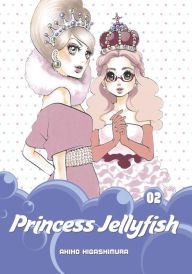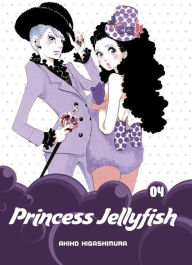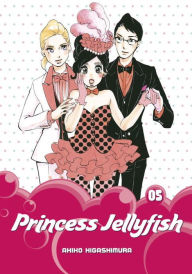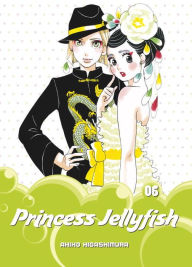How Shojo Gets Made: An Interview with Manga Editor Yuki Sukemune
 While it is not unusual for Japanese manga magazine editors to come to the U.S. for conventions, the ones who do are almost always men who edit shonen magazines like Shonen Jump (which carries Naruto and One Piece) or Monthly Shonen Magazine, home of Noragami. So it was a big deal that Yuki Sukemune, the editor of the shojo magazine Kiss and the manga Princess Jellyfish, made an appearance at this year’s Comic-Con International in San Diego. While our schedules did not allow for a sit-down interview at the con, I asked Sukimune if she would mind answering some questions via e-mail. In this interview, she presents her own insights into the manga creation process, and provides a very different picture of the industry than what we saw in Bakuman.
While it is not unusual for Japanese manga magazine editors to come to the U.S. for conventions, the ones who do are almost always men who edit shonen magazines like Shonen Jump (which carries Naruto and One Piece) or Monthly Shonen Magazine, home of Noragami. So it was a big deal that Yuki Sukemune, the editor of the shojo magazine Kiss and the manga Princess Jellyfish, made an appearance at this year’s Comic-Con International in San Diego. While our schedules did not allow for a sit-down interview at the con, I asked Sukimune if she would mind answering some questions via e-mail. In this interview, she presents her own insights into the manga creation process, and provides a very different picture of the industry than what we saw in Bakuman.
What shojo manga did you read when you were a girl? What was your favorite? Did you read shonen or other genres as well?
I first got my hands on shojo manga when I was in my third year of elementary school. A friend in my older sister’s class told me, “There are these manga magazines that we read, called Ribbon, Nakayoshi, and Ciao,” so I got my allowance together and headed to the bookstore. I still remember what the cover illustration of the first issue of Ribbon I bought looked like.
So that’s how I started reading Nakayoshi and Ribbon.
Sailor Moon 1
Sailor Moon 1
In Stock Online
Paperback
$6.92
$10.99
Pretty Guardian Sailor Moon, by Naoko Takeuchi, was being serialized in Nakayoshi, and I was hooked. Tenshi nanka ja nai, by Ai Yazawa, was running in Ribbon, and it similarly mesmerized me.
Sailor Moon was a fantasy, while Tenshi nanka ja nai was a more realistic high school love story—seemingly different genres—but they both celebrated the principle of living with courage, through the depiction of heroines who were older than me and who used their own strength to work for happiness or justice they believed in.
I think this was where I found the eternal theme of shojo manga: “Draw a heroine who goes through changes, and encourage the girls who are reading.”
When we went from being elementary schoolers to high school, we started reading shonen manga like Rurouni Kenshin (by Nobuhiro Watsuki) and Slam Dunk (by Takehiko Inoue).
Unlike the joy I experienced reading shojo manga, I think I enjoyed the excitement of peering into a boys’ world that I could never know myself, and I still treasure that feeling when I read shonen manga today.
I know you are the editor of Princess Jellyfish, but are you a magazine editor, and do you edit other stories as well?
In a typical Japanese shojo manga editorial department, each editor is responsible for about ten works being serialized at once, including in the main magazine, supplementary magazines, and digitally.
A few of the other manga I edit that are being serialized at the same time as Princess Jellyfish are Tokyo Tarareba Girls, also by Akiko Higashimura; Kakafukaka, by Takumi Ishida, about an unusual relationship between a girl and a boy that starts when they sleep next to each other; Gin no Spoon, by Mari Ozawa, which was adapted into a Japanese television drama; and My Name Is Noda, by Aya Tsuge.
At present, I am editing 11 ongoing series.
Pretty Guardian Sailor Moon, by Naoko Takeuchi, was being serialized in Nakayoshi, and I was hooked. Tenshi nanka ja nai, by Ai Yazawa, was running in Ribbon, and it similarly mesmerized me.
Sailor Moon was a fantasy, while Tenshi nanka ja nai was a more realistic high school love story—seemingly different genres—but they both celebrated the principle of living with courage, through the depiction of heroines who were older than me and who used their own strength to work for happiness or justice they believed in.
I think this was where I found the eternal theme of shojo manga: “Draw a heroine who goes through changes, and encourage the girls who are reading.”
When we went from being elementary schoolers to high school, we started reading shonen manga like Rurouni Kenshin (by Nobuhiro Watsuki) and Slam Dunk (by Takehiko Inoue).
Unlike the joy I experienced reading shojo manga, I think I enjoyed the excitement of peering into a boys’ world that I could never know myself, and I still treasure that feeling when I read shonen manga today.
I know you are the editor of Princess Jellyfish, but are you a magazine editor, and do you edit other stories as well?
In a typical Japanese shojo manga editorial department, each editor is responsible for about ten works being serialized at once, including in the main magazine, supplementary magazines, and digitally.
A few of the other manga I edit that are being serialized at the same time as Princess Jellyfish are Tokyo Tarareba Girls, also by Akiko Higashimura; Kakafukaka, by Takumi Ishida, about an unusual relationship between a girl and a boy that starts when they sleep next to each other; Gin no Spoon, by Mari Ozawa, which was adapted into a Japanese television drama; and My Name Is Noda, by Aya Tsuge.
At present, I am editing 11 ongoing series.
Princess Jellyfish 1
Princess Jellyfish 1
In Stock Online
Paperback
$15.39
$19.99
What do you think makes Princess Jellyfish special? How is it different from other shojo manga?
When the series started, Higashimura-sensei said to me, “Let’s make a modern version of a classic shojo manga.” Higashimura-sensei read shojo manga while trying to become a manga creator. Since her debut, she has written manga in all sorts of styles, but they have always unfailingly been shojo manga. She wanted Princess Jellyfish to be the final culmination of all that.
Therefore, the classic rule of shojo manga, “draw a heroine who goes through changes, and encourage the girls who are reading,” became its guiding light.
On another topic, we did upgrade a few things from classic shojo manga. They were, one, the diversity of the characters, and two, emphasizing more strongly that characters were growing while maintaining their idiosyncrasies.
I think it was quite novel to have a diverse range of otaku and cross-dressing main characters. Also, the series consistently features otaku who mature without leaving otakudom. Shining through it all is, I think, the strong desire to encourage self-affirmation among girls who live in a 21st century where all sorts of information is flying all over the place.
What do you think makes Princess Jellyfish special? How is it different from other shojo manga?
When the series started, Higashimura-sensei said to me, “Let’s make a modern version of a classic shojo manga.” Higashimura-sensei read shojo manga while trying to become a manga creator. Since her debut, she has written manga in all sorts of styles, but they have always unfailingly been shojo manga. She wanted Princess Jellyfish to be the final culmination of all that.
Therefore, the classic rule of shojo manga, “draw a heroine who goes through changes, and encourage the girls who are reading,” became its guiding light.
On another topic, we did upgrade a few things from classic shojo manga. They were, one, the diversity of the characters, and two, emphasizing more strongly that characters were growing while maintaining their idiosyncrasies.
I think it was quite novel to have a diverse range of otaku and cross-dressing main characters. Also, the series consistently features otaku who mature without leaving otakudom. Shining through it all is, I think, the strong desire to encourage self-affirmation among girls who live in a 21st century where all sorts of information is flying all over the place.
Princess Jellyfish 2
Princess Jellyfish 2
Paperback $19.99
How closely do you work with Akiko Higashimura on Princess Jellyfish? Do you discuss the story with her before she starts drawing each chapter?
I meet with Higashimura-sensei about once a week, and rather than a detailed discussion of plot development, we chat back and forth, sharing our larger vision, answering the questions, “what should appear in Princess Jellyfish?” or “what themes do we want to touch on in the future?”
Even when we do have a proper, formal discussion, talking about something completely different, we tend to suddenly end up back on that topic, so our method is extremely flexible. Anyway, no matter what form it takes, I think an editor’s job is to always keep up with the work and with the artist’s thought process.
Higashimura-sensei is the type of artist who has very clear ideas and structures in mind even in the rough layout stage, so we we’re able to have open and friendly chats on LINE [a messaging app], with me giving her my impressions and advice on how to make the story read better.
How closely do you work with Akiko Higashimura on Princess Jellyfish? Do you discuss the story with her before she starts drawing each chapter?
I meet with Higashimura-sensei about once a week, and rather than a detailed discussion of plot development, we chat back and forth, sharing our larger vision, answering the questions, “what should appear in Princess Jellyfish?” or “what themes do we want to touch on in the future?”
Even when we do have a proper, formal discussion, talking about something completely different, we tend to suddenly end up back on that topic, so our method is extremely flexible. Anyway, no matter what form it takes, I think an editor’s job is to always keep up with the work and with the artist’s thought process.
Higashimura-sensei is the type of artist who has very clear ideas and structures in mind even in the rough layout stage, so we we’re able to have open and friendly chats on LINE [a messaging app], with me giving her my impressions and advice on how to make the story read better.
Princess Jellyfish 4
Princess Jellyfish 4
Paperback
$15.39
$19.99
What is your day like? Do you spend it mostly in an office? Do you go to meetings every day, or do you spend most of your time reading and editing?
I don’t really have set work hours, so I work to my schedule for the day.
I have about 10 manga being serialized, but when you include works in development for serialization and rookie manga artists I might be advising, I might be making progress on about 20 manga at the same time, so each day I’m discussing about five works with artists. I have meetings in person, talk on the phone, and sometimes speak over Skype.
Aside from that, I drop by the office about once a day, because I also have to manage media adaptations of my manga, work on sales (giving the editor’s perspective on publicity for the manga), oversee proofreading and manuscript delivery, and manage authors.
Right now, I work about 10 hours a day, and I spend the rest of my time checking out other publishers’ magazines, watching movies, or watching TV (these activities strengthen my ability to structure and balance a manga).
What is your favorite part of your job? What is the most difficult part?
The thing I find the most enjoyable, that I like the most, is that I get to see talent up close. Being able to take in everything about a top author’s work is totally unique and stimulating, and I get excited just witnessing that.
The most difficult part is that, no matter how many ideas I might have about a manga, I’m not the one drawing it myself. I can only help guide the manga in a good direction by making the most of every opportunity for communication, no matter what type of person the author is, no matter what they’re looking at right now, what they’re thinking right now, or what kind of words will get my ideas across best.
So this job has its challenges, but it also has its interesting elements.
What is your day like? Do you spend it mostly in an office? Do you go to meetings every day, or do you spend most of your time reading and editing?
I don’t really have set work hours, so I work to my schedule for the day.
I have about 10 manga being serialized, but when you include works in development for serialization and rookie manga artists I might be advising, I might be making progress on about 20 manga at the same time, so each day I’m discussing about five works with artists. I have meetings in person, talk on the phone, and sometimes speak over Skype.
Aside from that, I drop by the office about once a day, because I also have to manage media adaptations of my manga, work on sales (giving the editor’s perspective on publicity for the manga), oversee proofreading and manuscript delivery, and manage authors.
Right now, I work about 10 hours a day, and I spend the rest of my time checking out other publishers’ magazines, watching movies, or watching TV (these activities strengthen my ability to structure and balance a manga).
What is your favorite part of your job? What is the most difficult part?
The thing I find the most enjoyable, that I like the most, is that I get to see talent up close. Being able to take in everything about a top author’s work is totally unique and stimulating, and I get excited just witnessing that.
The most difficult part is that, no matter how many ideas I might have about a manga, I’m not the one drawing it myself. I can only help guide the manga in a good direction by making the most of every opportunity for communication, no matter what type of person the author is, no matter what they’re looking at right now, what they’re thinking right now, or what kind of words will get my ideas across best.
So this job has its challenges, but it also has its interesting elements.
Princess Jellyfish 5
Princess Jellyfish 5
Paperback $19.99
How do you think the shojo manga industry has changed since you became an editor? Do readers prefer different types of stories now? Has your work life changed at all?
The Internet arrived, and the number of places where artists could present their work themselves, casually, for free, has grown. This is a good thing in that there’s a wider variety of places to discover new artists, but I also think the number of hurdles to a manga becoming a commercial hit has naturally multiplied as well. I think this is likely an overall market change affecting all genres, not just shojo manga, but readers’ standards for what is worth paying money for have become much harsher.
When it comes to the themes of shojo manga, I personally have to believe that the manga that have continuously depicted heroines who keep changing has a strong connection to the feminist consciousness of modern women.
Japanese women have recently begun to take action not only in ways that clearly lead to progress for women in society, like resisting sexual harassment or abuse of power, but also by declaring that we want to raise the profile of things we like rather than allow the world to be governed by men’s values, and I think Japan’s “kawaii” culture is connected to that.
Japanese girls who have naturally enjoyed shojo manga from the time they were little have great inner strength. They are the real-life versions of the shojo heroines that have always been depicted as possessing the strength of positive self-affirmation, gained by transforming themselves into who they want to be.
And there are quite a few former shojo manga readers who become josei manga readers when they get older.
How do you think the shojo manga industry has changed since you became an editor? Do readers prefer different types of stories now? Has your work life changed at all?
The Internet arrived, and the number of places where artists could present their work themselves, casually, for free, has grown. This is a good thing in that there’s a wider variety of places to discover new artists, but I also think the number of hurdles to a manga becoming a commercial hit has naturally multiplied as well. I think this is likely an overall market change affecting all genres, not just shojo manga, but readers’ standards for what is worth paying money for have become much harsher.
When it comes to the themes of shojo manga, I personally have to believe that the manga that have continuously depicted heroines who keep changing has a strong connection to the feminist consciousness of modern women.
Japanese women have recently begun to take action not only in ways that clearly lead to progress for women in society, like resisting sexual harassment or abuse of power, but also by declaring that we want to raise the profile of things we like rather than allow the world to be governed by men’s values, and I think Japan’s “kawaii” culture is connected to that.
Japanese girls who have naturally enjoyed shojo manga from the time they were little have great inner strength. They are the real-life versions of the shojo heroines that have always been depicted as possessing the strength of positive self-affirmation, gained by transforming themselves into who they want to be.
And there are quite a few former shojo manga readers who become josei manga readers when they get older.
Princess Jellyfish 6
Princess Jellyfish 6
Paperback $19.99
In America, we are familiar with the basic manga demographics—shonen, shoujo, etc.—but not how they are viewed in Japan. Do readers cross those lines—do girls read shonen manga, do boys read Princess Jellyfish? If so, has that changed the stories in any way?
Certain Japanese girls read shonen manga voraciously. I think that among them are those who, like I did reading shonen manga from the time I was young, feel a thrill from “peeking in on the world of boys,” while others simply find the stories appealing.
A majority of Princess Jellyfish readers are girls, or rather women, but there are also male readers. Their feelings reading the manga are, on the whole, the same as the girls and women reading.
Japanese manga magazines are divided into four categories: shonen, shojo, seinen, and josei. It is, of course, possible to enjoy one of the categories that’s not assigned to your gender by treating it as a peek at the other gender’s universe, but there’s also a big trend of major hit manga that can supersede gender categories and connect with everyone.
I never change a story’s structure on behalf of readers of the “other” gender, but I have worked with the manga author to identify elements that might move people and overcome gender categories. And, as an editor, I’m always trying to create manga like that, which can connect with readers universally.
Princess Jellyfish is available in English from Kodansha Comics.
In America, we are familiar with the basic manga demographics—shonen, shoujo, etc.—but not how they are viewed in Japan. Do readers cross those lines—do girls read shonen manga, do boys read Princess Jellyfish? If so, has that changed the stories in any way?
Certain Japanese girls read shonen manga voraciously. I think that among them are those who, like I did reading shonen manga from the time I was young, feel a thrill from “peeking in on the world of boys,” while others simply find the stories appealing.
A majority of Princess Jellyfish readers are girls, or rather women, but there are also male readers. Their feelings reading the manga are, on the whole, the same as the girls and women reading.
Japanese manga magazines are divided into four categories: shonen, shojo, seinen, and josei. It is, of course, possible to enjoy one of the categories that’s not assigned to your gender by treating it as a peek at the other gender’s universe, but there’s also a big trend of major hit manga that can supersede gender categories and connect with everyone.
I never change a story’s structure on behalf of readers of the “other” gender, but I have worked with the manga author to identify elements that might move people and overcome gender categories. And, as an editor, I’m always trying to create manga like that, which can connect with readers universally.
Princess Jellyfish is available in English from Kodansha Comics.





